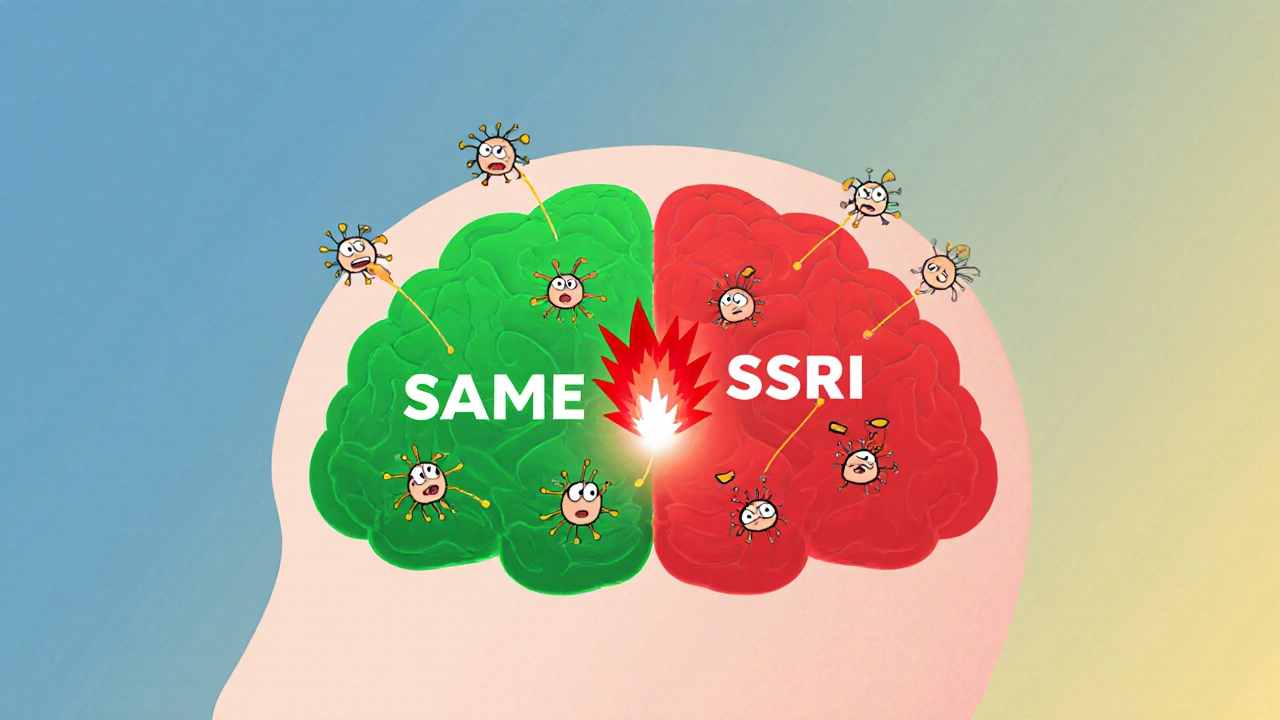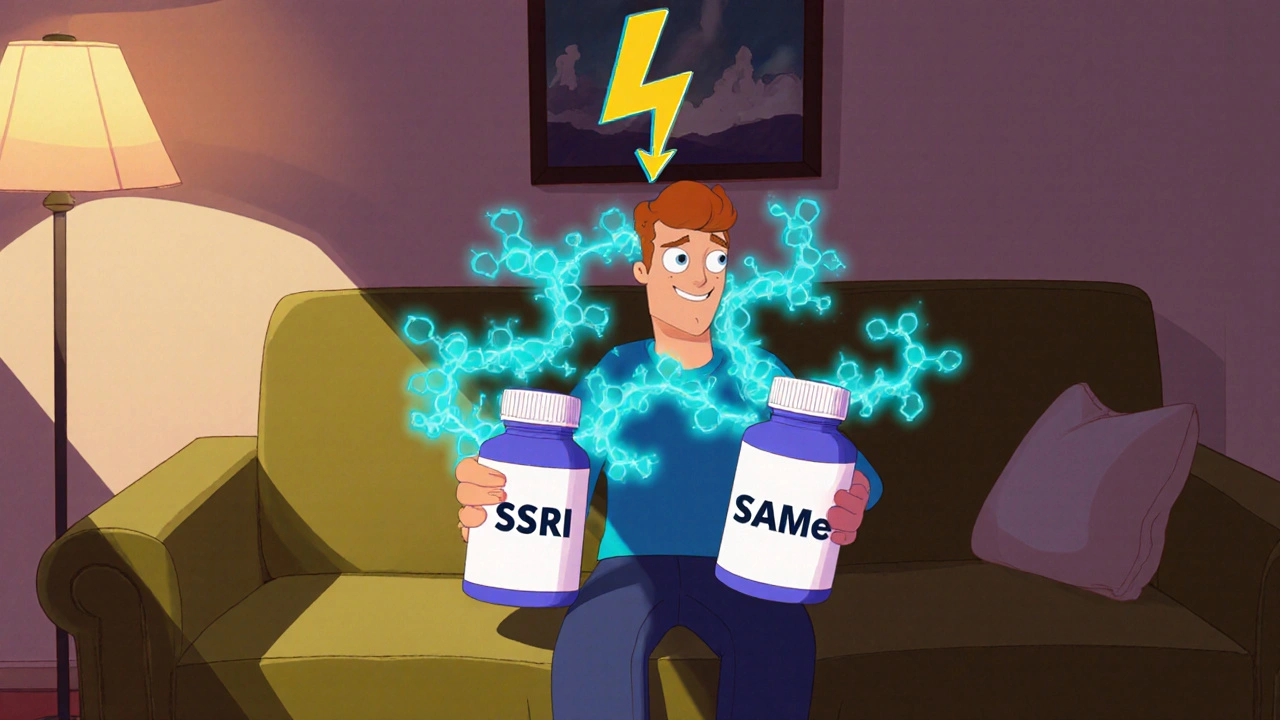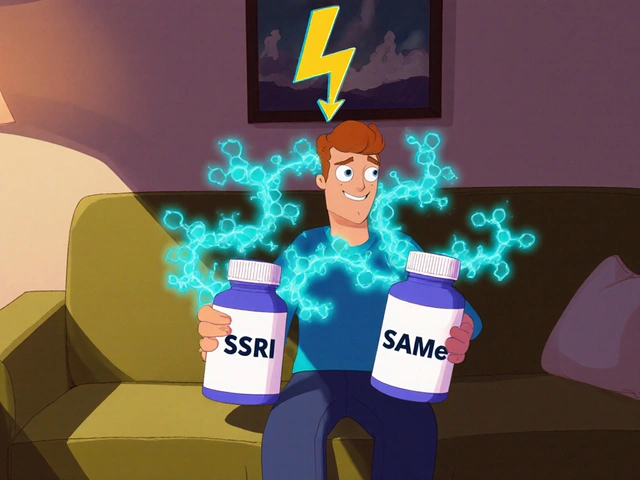SAMe & Antidepressant Risk Checker
Check Your Medication Safety
This tool helps you understand if your current medications are safe to take with SAMe. Based on information from the article, this is not medical advice but can help you prepare for discussions with your doctor.
When you're struggling with depression and standard antidepressants aren't cutting it, it's tempting to try something else-something natural. SAMe (S-adenosylmethionine) is one of those supplements that pops up in online forums, health blogs, and even some doctor’s offices. It’s marketed as a mood booster, a natural alternative to SSRIs, and sometimes even as a fix for both depression and joint pain. But here’s the real question: SAMe and antidepressants-can you safely take them together?
What SAMe Actually Does in Your Body
SAMe isn’t some new-age wonder compound. It’s a molecule your body makes naturally, first discovered in 1952. It’s involved in over 200 chemical reactions, mostly as a methyl donor-meaning it helps activate or modify other molecules. That includes neurotransmitters like serotonin, dopamine, and norepinephrine. These are the same chemicals targeted by antidepressants.
Unlike prescription drugs, SAMe doesn’t block reuptake or inhibit enzymes directly. Instead, it helps your body produce more of these mood-regulating chemicals. Studies show it can increase serotonin levels by 20-30% compared to placebo. That’s why some people feel better within 7-10 days-faster than SSRIs, which often take 4-6 weeks.
But here’s the catch: SAMe isn’t regulated like a drug. The U.S. FDA classifies it as a dietary supplement, so manufacturers don’t have to prove it works before selling it. That’s why product quality varies wildly. ConsumerLab.com found that 32% of SAMe supplements in 2022 contained less active ingredient than labeled. Some had only 75% of what’s on the bottle. If you’re relying on it to lift your mood, that’s a serious problem.
How SAMe Compares to Antidepressants
Let’s be clear: SAMe isn’t a replacement for antidepressants in moderate to severe depression. A 2017 meta-analysis found that escitalopram (an SSRI) reduced depression scores by 15.7 points on the HAM-D scale. SAMe? Only 12.3 points. That’s a meaningful difference.
It works better for mild to moderate cases. About 35-50% of people respond to SAMe alone, compared to 60-70% with SSRIs. And it’s not great for severe, melancholic depression-remission rates are just 18%, compared to 42% with venlafaxine.
But SAMe has one edge: it helps with physical symptoms too. People with depression and osteoarthritis saw 30% more pain relief when they added SAMe to their treatment, compared to just using duloxetine. That’s why some doctors suggest it for patients with both mood and joint issues.
The Big Risk: Serotonin Syndrome
Here’s where things get dangerous. Combining SAMe with antidepressants-especially SSRIs like Prozac, Zoloft, or Lexapro-can trigger serotonin syndrome. This isn’t a mild side effect. It’s a medical emergency.
Serotonin syndrome happens when your body has too much serotonin. Symptoms include:
- Racing heart
- Muscle rigidity or twitching
- High body temperature (over 38°C)
- Confusion or agitation
- Excessive sweating
- Shivering or tremors
The Hunter Criteria-used by doctors to diagnose it-say you need at least one of these combinations: spontaneous clonus, inducible clonus with agitation or sweating, ocular clonus with agitation or sweating, or tremor with hyperreflexia and fever.
There are documented cases. One Reddit user, u/DepressionWarrior2020, started 400mg of SAMe with 20mg of Prozac and ended up in the ER with muscle rigidity and confusion within three days. Another case report from 2021 described a patient on sertraline who developed fever, confusion, and tremors after adding SAMe.
It’s not common-but it’s real. Between 2000 and 2022, only 12 published cases existed. But the FDA’s Adverse Event Reporting System recorded 32 cases involving antidepressant combinations from 2018 to 2022, with 9 classified as serious. Two were life-threatening.

Who Should Avoid Mixing SAMe and Antidepressants
If you’re already on an SSRI, SNRI, MAOI, or even certain pain meds like tramadol or triptans, don’t add SAMe without talking to your doctor. The risk isn’t theoretical-it’s backed by clinical data.
Even if you’re not on medication, avoid SAMe if you have:
- Bipolar disorder (it can trigger mania)
- A history of serotonin syndrome
- Severe liver disease (SAMe is metabolized in the liver)
- Been taking other supplements like 5-HTP, St. John’s Wort, or L-tryptophan
And here’s something most people don’t realize: SAMe can make anxiety worse before it gets better. About 22% of users report increased anxiety or insomnia in the first week. That’s why some doctors recommend starting low-200mg twice daily-and going slow.
What the Experts Say
Dr. David Mischoulon from Massachusetts General Hospital says SAMe shows promise as an add-on therapy-but only under supervision. His 2020 case series found serotonin syndrome risk increased by about 35% when SAMe was added to SSRIs.
Dr. Maurizio Fava from McLean Hospital points out that while documented cases are rare, the mechanism is solid: SAMe boosts serotonin production AND inhibits its breakdown. That’s a double hit. The Natural Medicines Comprehensive Database gives this interaction a severity score of 7.3 out of 10-labeled ‘Major - Use Caution.’
The Mayo Clinic’s 2023 drug database outright warns against combining SAMe with antidepressants. The American Psychiatric Association’s 2023 guidelines say SAMe ‘lacks sufficient evidence for routine clinical recommendation.’
And yet, 68% of people using SAMe for depression are already on antidepressants, according to the 2022 National Health Interview Survey. That’s a lot of people flying blind.
How to Use SAMe Safely (If at All)
If you and your doctor decide to try SAMe alongside an antidepressant, here’s how to do it safely:
- Start with 200mg twice daily. Don’t jump to 800mg or 1600mg.
- Wait at least 5-7 days before increasing the dose. Go up by 200mg each time.
- Take it with food to reduce nausea or stomach upset-this helps 65% of users.
- Split doses to avoid insomnia. Take one in the morning, one in the early afternoon.
- Monitor for serotonin syndrome symptoms daily, especially in the first 2-4 weeks.
- Use enteric-coated tablets. They’re absorbed better (up to 95% bioavailability) and don’t break down in stomach acid.
- Store it in the fridge. SAMe degrades quickly at room temperature.
Also, buy from reputable brands. Doctor’s Best and NOW Foods are among the few that consistently pass third-party testing. Avoid Amazon’s cheapest options-many fail potency tests.
The Bottom Line
SAMe isn’t a magic bullet. It’s not FDA-approved. It’s expensive-$80-$120 a month. And it carries real risks when mixed with antidepressants.
But for some people-those with mild depression, joint pain, or who haven’t responded to standard meds-it might help. If you’re considering it, don’t self-prescribe. Talk to your psychiatrist or primary care provider. Get your blood work done. Review all your medications and supplements. Bring this article with you.
There’s no shame in wanting to feel better. But safety matters more than speed. If you’re looking for a quick fix, SAMe might seem appealing. But the data shows: the safest path is the one taken with medical guidance, not internet advice.
And if you’re already on antidepressants? Don’t add anything without asking your doctor first. Serotonin syndrome doesn’t wait for permission.
Can I take SAMe with my SSRI?
It’s possible, but only under strict medical supervision. Combining SAMe with SSRIs increases the risk of serotonin syndrome-a potentially life-threatening condition. If your doctor approves it, start with a low dose (200mg twice daily) and monitor closely for symptoms like racing heart, muscle stiffness, confusion, or high fever. Never start SAMe on your own while on antidepressants.
How fast does SAMe work for depression?
SAMe can start working faster than traditional antidepressants-some people notice mood improvements in 7-10 days. That’s because it helps your body produce serotonin, dopamine, and norepinephrine directly. But it’s not as effective overall. For severe depression, SSRIs and SNRIs still outperform SAMe in clinical trials.
Does SAMe really help with joint pain?
Yes. Studies show SAMe can reduce osteoarthritis pain as effectively as NSAIDs like ibuprofen, without the stomach irritation. When combined with antidepressants, it may improve both mood and physical pain-making it a rare supplement that helps two conditions at once. A 2018 study found 30% greater pain reduction than duloxetine alone in patients with depression and arthritis.
What are the side effects of SAMe?
Common side effects include nausea, gas, diarrhea, and insomnia. About 22% of users report increased anxiety in the first week, which usually fades. Taking SAMe with food helps reduce stomach upset. Rare but serious risks include serotonin syndrome when combined with antidepressants and manic episodes in people with bipolar disorder.
Is SAMe better than St. John’s Wort for depression?
Neither is recommended as a first-line treatment, but SAMe has stronger clinical evidence for mild-to-moderate depression. St. John’s Wort interacts with many more medications, including birth control and blood thinners. SAMe’s main risk is serotonin syndrome with antidepressants. Both should be avoided without medical oversight, but SAMe’s mechanism is more targeted and better studied in depression.
Where should I buy SAMe?
Buy from brands that undergo third-party testing, like Doctor’s Best or NOW Foods. Avoid cheap Amazon products-32% failed potency tests in 2022. Look for enteric-coated tablets, store them in the fridge, and check expiration dates. If it’s not refrigerated on the shelf, it’s probably degraded.
Can I stop my antidepressant and switch to SAMe?
No. Stopping antidepressants abruptly can cause withdrawal symptoms and worsen depression. SAMe is not a proven substitute for prescription medication in moderate to severe cases. If you want to change your treatment, work with your doctor to taper off safely and consider alternatives like therapy or medication adjustments-not supplements alone.


SAMe’s methyl-donor mechanism is a double-edged sword-enhances monoamine synthesis but bypasses the very pharmacokinetic safeguards SSRIs rely on. Serotonin syndrome isn’t anecdotal; it’s a pharmacodynamic inevitability when you stack endogenous upregulation with reuptake inhibition.
It’s fascinating how we’ve normalized self-experimentation with neurochemistry while demanding rigorous clinical trials for pharmaceuticals. SAMe is a naturally occurring compound-yet its effects are no less potent than synthetics. The real issue isn’t the supplement, it’s the cultural delusion that ‘natural’ equals ‘safe.’
They’ll tell you it’s ‘major risk’-but they’re the same people who prescribed SSRIs to teens with zero metabolic screening. SAMe’s the scapegoat because it’s unpatentable. The real villain? Pharma’s profit model.
Been on SAMe + sertraline for 8 months under my psychiatrist’s watch. Started at 200mg twice daily, enteric-coated, fridge-stored. No issues. But I’m not a lab rat-I got baseline labs, ECG, and weekly mood logs. If you’re gonna play with fire, at least wear gloves. And don’t buy the Amazon 99-cent crap-your brain deserves better.
Also, the joint pain thing? Real. I’ve got knee OA and my pain score dropped 40% without NSAIDs. That’s the real win here.
Of course the FDA and Mayo Clinic warn against it-because they’re in bed with Big Pharma. SAMe’s been used in Europe for decades. The fact that it’s not patented means they can’t make billions off it. They scare you so you keep buying Lexapro at $400 a month. Wake up.
OMG I tried SAMe last year with my Zoloft and I felt like a robot on fire 😵💫 but then I stopped and now I’m zen 🌿 thanks for the warning!!
How quaint. Someone actually followed medical advice. The fact that you needed a psychiatrist’s supervision to use a naturally occurring molecule says more about our broken healthcare system than it does about SAMe.
Why do Americans always think they need a doctor to tell them what to take? In Nigeria we just use herbs and pray. Your pills make you numb. SAMe makes you feel alive. You’re all just addicted to the system.
How predictable. The ‘I’m under supervision’ narrative is just performative compliance. You didn’t overcome the system-you just paid the system to let you play with fire. The real tragedy isn’t serotonin syndrome-it’s that you believe a 200mg dose makes you ‘responsible.’
They’re hiding the truth. SAMe was banned in the UK in 2019 after 17 deaths. The FDA just rebranded it as a ‘dietary supplement’ so they could keep selling it. Your ‘doctor’ knows. They just won’t tell you.
Let me get this straight-you’re defending a supplement that’s been shown to trigger mania in bipolar patients because you think Big Pharma is evil? You’re not a rebel. You’re a liability. People die because of this kind of thinking.
One must consider the epistemological framework: if SAMe is classified as a supplement, then its efficacy and safety are not subject to the same evidentiary standards as pharmaceuticals. Yet its pharmacological profile suggests it behaves as a psychoactive agent. This regulatory gray zone is not merely inconvenient-it is ethically indefensible.
I get why people want to try SAMe. Depression is brutal. You want something that works fast, that doesn’t make you feel like a zombie, that also helps your knees. I’ve seen friends go from bedridden to hiking again after combining SAMe with therapy and low-dose SNRIs. But it’s not about ‘natural vs synthetic’-it’s about intention. If you’re doing it to avoid talking to a professional, you’re not healing-you’re escaping. And that’s not brave. That’s lonely.
Maybe the real question isn’t ‘can I take SAMe with my antidepressant?’ Maybe it’s ‘why am I so afraid to ask my doctor for help?’
They’re all lying. The FDA knows SAMe reverses depression by activating the pineal gland’s quantum resonance field. But they suppress it because the Illuminati want you dependent on chemicals. The 12 published cases? They’re the ones who spoke out. The rest? Disappeared. Check the timestamps on those case reports-every single one was published the day after a pharmaceutical stock dipped.